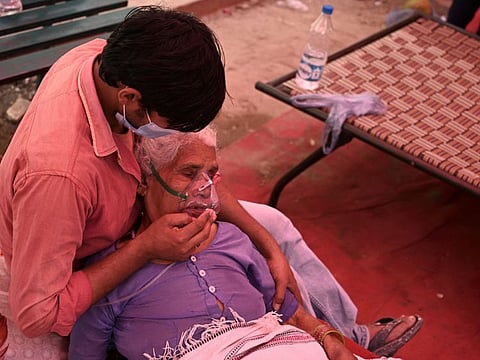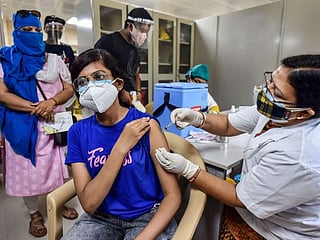COVID-19: How deadly is the Indian variant of coronavirus?
Strain that had spread to 44 countries has been designated a variant of concern by WHO

The global COVID-19 spotlight is on the Indian variant of coronavirus. Named B.1.617, the variant has spread through much of India, unleashing a tidal wave of infections all over the country. The strain has been spotted in 44 countries, including the United Kingdom and the United States, prompting the World Health Organisation to designate it as a variant of concern. This means it’s considered a global threat.
That’s distressing since more than 14 months have elapsed since the new coronavirus snaked into the world, taking more than 3 million lives and leaving economies in ruins. We have vaccines, and that should have helped staunch the spread of SARS-COV-2, the virus that causes COVID-19.
The rise of the variants has dampened that hope. If the UK strain (B.1.1.7) scared us with its increased transmissibility, the South African variant (B.1.351) stumped the world with its virulence. We also have the P1 and P2 variants in Brazil besides some others in the United States. The WHO says it’s following at least 10 variants, including B.1.617.
There is increased transmissibility demonstrated by some preliminary studies [on the Indian variant].Dr Maria Van Kerkhove, the technical lead of the WHO’s COVID-19 response unit
Why is the Indian variant a worry? Much of it stems from the lack of data. Not enough studies have been done on the B.1.617, and a study on a limited number of patients hasn’t been peer-reviewed. Meanwhile, a survey by researchers at Imperial College London found that the India variant could be spreading faster than the UK variant, at least in London.
Dr Maria Van Kerkhove, the technical lead of the WHO’s COVID-19 response unit, said: “There is increased transmissibility demonstrated by some preliminary studies,” adding that antibodies triggered by past infections and vaccines may not fully protect us from the Indian variant.
Even if COVID-19 vaccines don’t ward off coronavirus infections completely, they still provide some form of protection against most variants. So if a vaccinated person contracts the disease, the severity will be significantly reduced.
Here’s what we know of the Indian variant.
What’s the Indian variant?
The Indian variant, named B.1.617, was first identified in the western state of Maharashtra in December, although an earlier version was found in October. And on March 24, 2021, the Indian health ministry reported that 15-20% of the coronavirus cases were caused by this strain. Now infections by B.1.617, which has at least two worrying mutations in the spike protein, is reported to have crossed 60%.
The original India variant, known as B.1.617, has now been re-characterised as three different sub-types, each with different mutations. B.1.617 is now called B.1.617.1, and the other two are B.1.617.2 and B.1.617.3. All of them have slightly different mutations, but they all share E484Q and L452R mutations.
Why is it called a double mutant or a triple mutant?
Double mutant and triple mutant are names bandied about in the media, much to the consternation of Indian researchers. Because they are misnomers since the B.1.617, and its variants carry 13 to 17 mutations. Seven of them are in the spike protein.
The India variant was dubbed the “double mutant” variant because it contains two mutations of interest, E484Q and L452R, on the spike protein.
Besides E484Q and L452R, the virus also has V382L in its spike. That’s where the name triple mutant come from? “It’s a shorthand for three mutations that are significant,” Amesh Adaljia, assistant professor at Johns Hopkins University’s Bloomberg School of Public Health, was quoted as saying. “There are three mutations amongst a whole cluster of mutations that have been associated with increased transmissibility or immune evasion.”
The L452R mutation, which was first noticed in the California variant, may make it up to 20% more transmissible than wild-type strains. The E484Q is similar to the E484K mutations found in the B.1.351 (South African) and P.1 (Brazilian) variants.
How dangerous is the Indian variant?
There’s no firm answer right now. Studies are underway to determine whether the variants are more dangerous than the ones in circulation. B.1.617.2 is now treated as a “variant of concern”. That could be possibly due to the initial results from epidemiological analyses.
Results from Prof Ravi Gupta’s team at the University of Cambridge in the UK suggested that the Indian variants might be more transmissible than the original strain due to a mutation called P681R. Experiments have shown that this mutation might help the virus to enter cells, a Guardian report said.
“It seems to be circulating, at least in London, and it is at least as transmissible as the Kent [UK] variant. We need to understand more about it,” Prof Paul Elliott, director of the React programme at Imperial College London, said:
Tom Wenseleers, professor of evolutionary biology at the University of Leuven, Belgium, feels the Indian variant of concern could be 60% more transmissible than the UK variant. But several other experts and scientists are sceptical and called for definitive data.
Is it responsible for the second wave in India?
There’s a section of doctors in India who think that the massive spike in COVID-19 infections is driven by the three Indian strains. But experts abroad are sceptical for the sheer want of data, and they warn against jumping to conclusions too soon. They say several other factors, including public apathy, the government’s lack of preparedness and poor public medical infrastructure, contributed to the situation.
Dr Zarir Udwadia, a doctor in Mumbai, was quoted by Mail Online as saying the B.1.617 variant is to be blamed for the high number of cases. He said the strain was far more infectious and probably far more deadly than previous strains.
Dr Vineeta Bal, an immunologist and a visiting professor at the Indian Institute of Science Education and Research in Kolkata, seems to agree but calls for more data. “It seems to be the case, but we cannot say it scientifically [that the variant is linked to the surge]. We cannot say so as we have sequenced very small numbers of samples, some 15,000 so far, and we so do not have adequate data to conclude that the B.1.617 variant is responsible for the surge,” Dr Bal told News 18, a news channel in India.
So basically, Dr Bal too agrees with the overseas scientists: more data are needed.
Why is there a lack of data on the Indian strain?
Indian scientists blame the lack of data on the government’s reluctance to share the figures. Researchers say bureaucratic hurdles have hamstrung their attempts at sequencing, and as a result, only around 1% of the total cases have been sequenced.
Since most of the raw materials are imported, it requires plenty of paperwork, Anurag Agarwal, the director of the Institute of Genomics and Integrative Biology, told the Associated Press. In January, a federal effort allowed 10 labs to sequence 7,500 samples weekly. Still, work didn’t start until mid-February due to other logistical issues, said Dr Shahid Jameel, a virologist who chairs the scientific advisory group advising the consortium.
Poor sequencing is a worry. “When there isn’t enough sequencing, there will be blind spots and more worrisome mutations could go undetected until they’re widespread,” the Associated Press quoted Alina Chan, a postdoctoral researcher at Broad Institute of MIT and Harvard, as saying
Sequencing efforts in India have been very patchy. "The country uploads 0.49 sequences per 1,000 cases to GISAID, a global data-sharing effort," Chan said. This is frustrating for scientists worldwide since the strain has spread to 44 countries. Without genetic monitoring, it’s impossible to learn about the mutations and their effect on vaccines and the strain’s potential for reinfection. That has resulted in a clamour for more data on the variant.
Will the variant evade vaccines?
E484Q and L452R are called escape mutations since it helps the spike proteins to evade antibodies. Studies suggest these mutations could make the virus more transmissible. Some reports say the L452R mutation could allow the virus to dodge antibodies from vaccination, And E484Q is similar to the E484K mutation that makes the South African and Brazilian variants partially resistant to vaccines.
Research published in the journal Cell Host & Microbe said E484Q was able to evade antibodies in convalescent plasma. An article in Cell found that variants with L452R are more resistant to antibodies.
But scientists are united in the opinion that the mutations in the Indian strain are unlikely to render vaccines ineffective, given the nature of the vaccines. That found favour with BioNTech co-founder Ugur Sahin.
He was confident that the Pfizer-BionNTech vaccine is effective against the Indian variant. “We are still testing the Indian variant, but the Indian variant has mutations that we have already tested for and which our vaccine works against, so I am confident,” Sahin said.
At least one study showed a drop in vaccine efficacy against the E484Q and L452R mutations. Early results from Gupta’s team of researchers at the University of Cambridge show that antibodies generated by one dose of the Pfizer vaccine have a four-fold to six-fold lower ability to neutralise the variant compared with the early form of the virus, the Guardian reported. The E484K mutation in the South African variant has been linked to a ten-fold reduction.
The good news is that researchers at the National Institute of Allergy and Infectious Diseases in Maryland, US, found that T-cells could recognise mutated forms of the coronavirus. So vaccinated people or previously infected persons are unlikely to have severe infections from the new strains.
How far has it spread?
The Indian variant has been found in dozens of countries, the WHO said on Wednesday. The UN health agency said the B.1.617 variant had been detected in more than 4,500 samples uploaded to an open-access database “from 44 countries in all six WHO regions”, including the United States. The New York Times on Thursday said the strain has spread to 49 countries,
The WHO said it had received reports of detections from five additional countries. Outside India, UK had reported the largest number of infections caused by the variant, it added.
Should we be worried?
Yes, we should be, since not much is known about the Indian variant. Some experts say the strain might be helping to fuel the rise in India’s infections, which they say could be undercounted. As the crisis deepens in India, the WHO has termed the B.1.617 strain as a variant of concern.
“We need to keep a close eye on this variant,” Katelyn Jetelina of the University of Texas Health Science Centre at Houston, US, wrote in a newsletter. “Just because there are two worrisome mutations on one variant doesn’t necessarily mean this is [doubly] contagious or [doubly] deadly.”
All this points to a lack of clarity. And clarity can only come from studies of a larger sample. With the Indian variant spreading to more than 40 countries, there will be more data soon. And that will help understand the true nature of the strain. Till then, let’s mask up and stay safe.
Sign up for the Daily Briefing
Get the latest news and updates straight to your inbox









